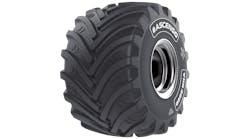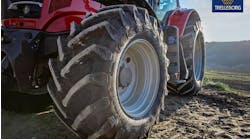Modern Tire Dealer has partnered with AG Tire Talk to provide answers to insightful questions that farm tire dealers have about farm tire technology. This is the next installment in our ongoing series, which is designed to help farm tire dealers better connect with their customers. A trending question, followed by answers, will appear in our Commercial Tire Dealer section every other month. For complete answers, click on www.agtiretalk.com.
Question: On combines, when do you recommend duals or super singles? What specific applications are best for each, and what performance benefits/drawbacks can producers anticipate receiving from each setup?
Nick Phillippi, technical support and product development, North America, Ascenso Tires North America: Recommending a fitment for a specific harvester is difficult from a 30,000-foot level, whether being a manufacturer or wholesale distributor. Then when you talk about all the variables to consider — soil types, moisture condition, stubble issues, transport width, tracking down the row, local tire dealer support, customer preference and others — it gets even tougher.
Certainly, these four application basics must be met: load capacity, speed rating, size tolerances and wheel fitment. The second set of parameters includes budget, length of time of ownership left, past problems to solve and satisfaction with current setup. Generally speaking, if the correct field air pressure is maintained with VF load tables on the largest dual fitment, then we believe straddle duals will make the case of the best overall option.
Dave Paulk, manager, field technical services, BKT USA Inc.: Duals work well on combines in moist to dry conditions. Duals can help carry more load and help distribute that load over a wider area to minimize soil compaction with the correct air pressures.
In wet conditions, duals are more likely to cause ruts and collect mud between the duals. In muddy conditions, it is necessary to keep the mud cleaned out between duals to decrease the possibility of stalks and rocks damaging the sidewalls of the tires. If the field is too wet and ruts are deep, it takes some time to repair the soil from the compaction caused.
Super singles work well on combines in dry soil and have better flotation in moist and wet soil than duals. In moderately dry soil, super singles have a much wider footprint to distribute the weight of the machine and load and minimize soil compaction. Some super singles are increased flexion (IF) or VF tires and can carry larger loads at slower speeds.
Super singles do not cause ruts as bad or as deep as duals in wet and muddy soil. However, depending on the type of soil, super singles may not clean out as well because of the width of the tires. If they don’t clean out as well as they should, similar to duals, they can become slick and lose traction. This could cause deeper rutting, damage to the soil from spinning and possible damage to the tire.
In a perfect world, if no-till or minimum-till farming is used, it’s best to stay off the field in muddy conditions to minimize the possibility of compacting the soil. It takes a while to repair this compaction, once this is done. Unfortunately, it isn’t always possible when a crop must be taken out.
Greg Gilland, vice president, global agriculture, Maxam Tire North America Inc.: It is often argued by farmers and growers that the most important platform in their fleet of equipment is their combine-harvester. This is the vehicle that ultimately allows them to harvest their crop to sell in the market and achieve sustainable business profits.
But harvesters, whether owned or leased, tend to be the least-used piece of equipment on a farm. Harvesters also are typically the longest-lasting piece of equipment in terms of total hours of use, as their wear and tear only occurs during harvest, when comparing to the service or working hours experienced by tractors or self-propelled sprayers. In some instances, depending on the care or maintenance of the equipment, it can take up to 10 years to consume the original, factory-mounted tires. The overall key market drivers for tires or tracks employed on a harvester are listed below:
- Farmers or growers own an estimated 88,000-plus combines in North America;
- Currently, custom harvesters account for about 3,000 to 5,000 harvesters operating across both the U.S. and Canada; and
- Combine harvesters are used for an average of 300 to 400 operating hours per year, regardless of crop or application, and immediately after the harvest, the vehicle is parked and prepared for the following season’s harvest.
Sought-after performance benefits include the ability of the tires to resist stubble or tread damage; long-term tire wear rate to deliver longer product life or performance; tire casing durability over the life of the tires; the ability to operate at lower tire pressure to increase flotation and to reduce overall soil compaction; the ability to deliver traction and grip to lower machine slip resulting in increased productivity; increased mobility with improved flotation and tread grip; and the ability to travel over the field, delivering the necessary footprint to avoid field rutting that can lead to greater ground compaction.
Ultimately, it’s the size of the farm, type of crop and how the equipment is utilized — or the inherent operational requirements — that will determine the type of combine-harvester used and the size or type of tires required. The biggest driver of combine-harvester tire choices will be dictated by the type of crop and farming practices.
David Graden, operational market manager, agriculture, Michelin North America Inc.: Often, I get asked this question by producers looking to minimize their downtime during the harvest season, first and foremost. Second to that, they want to reduce their machine’s impact on the soil, especially in wet conditions.
Unfortunately, many folks think large single/floater tires always offer the best floatation. While that may be true, in some cases, it doesn’t guarantee floatation and traction. In wet conditions, these wide tires can pack with mud and completely lose their tractive capacity. As these tires spin, they can create massive ruts, compact your soil and dig themselves into a hole, having a major negative impact on your customer’s yield for years to come.
The easiest way to compare tires in regard to soil compaction is by evaluating field air pressure, choosing the product with lowest inflation pressure able to carry the load at the speed they are traveling. Why? Air pressure reductions equate to fewer pounds per square inch transmitted to the soil. In other words, pressure to soil is a linear equation to tire PSI, so as you reduce air pressure in the tire, you are reducing pressure to the soil and reducing soil compaction.
Blaine Cox, national product manager — agriculture, golf and turf, Yokohama Off-Highway Tires America Inc.: There are a number of variables to consider when deciding between duals and large singles on combines — ranging from the size and capacity of the machine to the soil type, moisture levels and even the width of local roads. In most situations, except very wet soils, properly inflated tires can deliver equivalent traction and minimize soil compaction.
Dual configurations can spread the load over a larger surface, which is obviously effective for reducing soil compaction force. However, if you are using the combine in gumbo, sticky mud or muck, the space between the duals can fill up with mud, reducing overall performance. Also for many operators, the result can be a combine too wide for roading or even storage in some sheds, and, of course, more tires means more cost.
VF tire technology has also dramatically changed farmers’ options when it comes to tire performance in combines.
Since inflation pressure is such an important part of performance, it’s worth considering also investing in a central tire inflation system (CTIS), which allows the operator to adjust inflation pressure on the go. That ensures a low, compaction-minimizing inflation pressure on the field and a quick switch to a higher pressure for better roading. Optimizing inflation pressure ensures optimal performance and can add significantly to tire life, making CTIS an investment that pays off very quickly.
Just as important as the tires is how you use the combine. If compaction is a concern, consider not filling up the grain tank. Instead, off-load grain sooner, while minimizing cart or semi traffic “shortcuts” across the field. Make sure your grain cart tires are also high-flotation and that they are inflated properly to minimize compaction.
Chris Neidert, ag marketing, training and development manager for Trelleborg and Mitas tires, North America, Yokohama TWS: When looking at the U.S. combine market’s needs and preferences, we can divide them in two large groups based on the crop they harvest: super singles (small grain) and duals (large grain).
Many harvesters will harvest wheat and small grain. Super singles is the predominate choice of tires versus a dual set-up. The main reason would be ease of transport from one customer’s field to the next, as most of these combines are transported on trucks and the outer duals would have to be dismounted, requiring additional equipment to handle them. Small grain crops stems are weaker, reducing the possibility to damage the tires. Popular sizes are 800 or 900 cross-sections that can handle the weight of most small grain headers. (Usually a header on a wheat harvesting combine will be lighter and the single tire setup will be OK.)
Duals will be mainly (used for) combining corn and soybeans. Different (than) small grains, corn and soybean maturity is more concentrated in time, not allowing for custom harvesters to have a long harvest run. These combines are used most often locally and not transported on trucks. Here a dual fitment is the setup of choice. Using duals, the grower will enjoy better lateral stability in the field and when roading the combine. Many times, the header stays on the machine, even when roading. This dual configuration provides additional load capacity for the combine, especially when fitted with corn headers that are heavier than a soybean header. Most popular dual combine sizes vary between 520, 580 and 620 cross-sections.
Corn or soybean headers are usually heavier, sometimes up to double the weight. Running a dual setup will be able to handle that additional weight on the front of the combine. Running duals (also) will (result in) less stubble damage because the tires can possibly go in between the rows and help minimize stubble damage. Super singles will have to travel over the stubble and additional stubble damage can occur.




